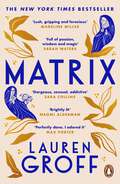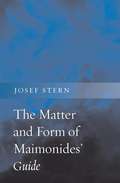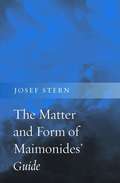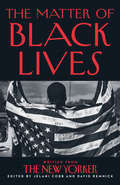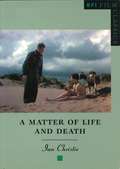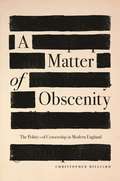- Table View
- List View
The Matrix (BFI Film Classics)
by Joshua CloverThe Matrix (1999), directed by the Wachowski sisters and produced by Joel Silver, was a true end-of-the-millennium movie, a statement of the American zeitgeist, and, as the original film in a blockbusting franchise, a prognosis for the future of big-budget Hollywood film-making. Starring Keanu Reeves as Neo, a computer programmer transformed into a messianic freedom fighter, The Matrix blends science fiction with conspiracy thriller conventions and outlandish martial arts created with groundbreaking digital techniques. A box-office triumph, the film was no populist confection: its blatant allusions to highbrow contemporary philosophy added to its appeal as a mystery to be decoded. In this compelling study, Joshua Clover undertakes the task of decoding the film. Examining The Matrix's digital effects and how they were achieved, he shows how the film represents a melding of cinema and video games (the greatest commercial threat to have faced Hollywood since the advent of television) and achieves a hybrid kind of immersive entertainment. He also unpacks the movie's references to philosophy, showing how The Matrix ultimately expresses the crisis American culture faced at the end of the 1990s.
The Matrix (BFI Film Classics)
by Joshua CloverThe Matrix (1999), directed by the Wachowski sisters and produced by Joel Silver, was a true end-of-the-millennium movie, a statement of the American zeitgeist, and, as the original film in a blockbusting franchise, a prognosis for the future of big-budget Hollywood film-making. Starring Keanu Reeves as Neo, a computer programmer transformed into a messianic freedom fighter, The Matrix blends science fiction with conspiracy thriller conventions and outlandish martial arts created with groundbreaking digital techniques. A box-office triumph, the film was no populist confection: its blatant allusions to highbrow contemporary philosophy added to its appeal as a mystery to be decoded. In this compelling study, Joshua Clover undertakes the task of decoding the film. Examining The Matrix's digital effects and how they were achieved, he shows how the film represents a melding of cinema and video games (the greatest commercial threat to have faced Hollywood since the advent of television) and achieves a hybrid kind of immersive entertainment. He also unpacks the movie's references to philosophy, showing how The Matrix ultimately expresses the crisis American culture faced at the end of the 1990s.
Matrix: THE NEW YORK TIMES BESTSELLER
by Lauren GroffNOW AVAILABLE TO PREORDER: the new historical novel from the bestselling author of Fates and Furies'Lush, gripping and ferocious, MATRIX is animated with sensual detail on every page' MADELINE MILLER'An audacious piece of storytelling, full of passion, wisdom and magic' SARAH WATERS'MATRIX is a gorgeous, sensual, addictive read' SARA COLLINS__________________________________Seventeen-year-old Marie, too wild for courtly life, is thrown to the dogs one winter morning, expelled from the royal court to become the prioress of an abbey. Marie is strange - tall, a giantess, her elbows and knees stick out, ungainly.At first taken aback by life at the abbey, Marie finds purpose and passion among her mercurial sisters. Yet she deeply misses her secret lover Cecily and queen Eleanor.Born last in a long line of women warriors and crusaders, women who flew across the countryside with their sword fighting and dagger work, Marie decides to chart a bold new course for the women she now leads and protects. She will bring herself, and her sisters, out of the darkness, into riches and power. MATRIX is a bold vision of female love, devotion and desire from one of the most adventurous writers at work today.__________________________________'A thrillingly vivid, adventurous story about women and power that will blow readers' minds. Left me gasping.' EMMA DONOGHUE'Both epic and intimate, this sweeping novel explores questions of female ambition, creativity and passion with electrifying prose and sparkling wit. A propulsive, captivating read' BRIT BENNETT
The Matrix of Modernism: Pound, Eliot, and Early Twentieth-Century Thought
by Sanford SchwartzSanford Schwartz situates Modernist poetics in the intellectual ferment of the early twentieth century, which witnessed major developments in philosophy, science, and the arts. Beginning with the works of various philosophers--Bergson, James, Bradley, Nietzsche, and Husserl, among others--he establishes a matrix that brings together not only the principal characteristics of Modernist/New Critical poetics but also the affiliations between the Continental and the Anglo-American critical traditions.Originally published in 1985.The Princeton Legacy Library uses the latest print-on-demand technology to again make available previously out-of-print books from the distinguished backlist of Princeton University Press. These editions preserve the original texts of these important books while presenting them in durable paperback and hardcover editions. The goal of the Princeton Legacy Library is to vastly increase access to the rich scholarly heritage found in the thousands of books published by Princeton University Press since its founding in 1905.
The Matrix of Visual Culture: Working with Deleuze in Film Theory (Cultural Memory in the Present #440)
by Patricia PistersThis book explores Gilles Deleuze's contribution to film theory. According to Deleuze, we have come to live in a universe that could be described as metacinematic. His conception of images implies a new kind of camera consciousness, one that determines our perceptions and sense of selves: aspects of our subjectivities are formed in, for instance, action-images, affection-images and time-images. We live in a matrix of visual culture that is always moving and changing. Each image is always connected to an assemblage of affects and forces. This book presents a model, as well as many concrete examples, of how to work with Deleuze in film theory. It asks questions about the universe as metacinema, subjectivity, violence, feminism, monstrosity, and music. Among the contemporary films it discusses within a Deleuzian framework are Strange Days, Fight Club, and Dancer in the Dark.
Matron at Last
by Evelyn Prentis'When do you have a bath?' I asked Mrs Turgoose. 'I hope you're not suggesting that I don't look after meself properly,' she said crossly. 'There was a woman who used to use it, but that was because she was a bit stuck up. She soon went off the idea when it started to get cold.'After working as a nurse for thirty years, Evelyn left the hospital to become a full-time Matron at The Lodge - a home for elderly ladies of reduced circumstances. Evelyn was nothing like the matrons she had known and feared in the past. In spite of broken nights and hot dinners left to get cold, Mrs Peters with her temper and Mrs Harrison with her 24-hour piano playing, her new role offered a chance to make a difference to her ladies' lives. Even though it did mean she was on call twenty-four hours a day, this is Evelyn's funny and affectionate memoir of her years - at last! - as a Matron.
Matrona Docta: Educated Women in the Roman Elite from Cornelia to Julia Domna
by Emily A. HemelrijkMatrona Docta presents a unique study of the education of upper-class women in Roman society in the central period of Roman history, from the second century BC to AD 235.Emily A. Hemelrijk reconstructs women's opportunities to acquire an education, the impediments they faced, the level of education they could reach and the judgement on educated women in Roman society. She examines also the role of women as patronesses of literature, learning and Roman women's writing.
Matrona Docta: Educated Women in the Roman Elite from Cornelia to Julia Domna
by Emily A. HemelrijkMatrona Docta presents a unique study of the education of upper-class women in Roman society in the central period of Roman history, from the second century BC to AD 235.Emily A. Hemelrijk reconstructs women's opportunities to acquire an education, the impediments they faced, the level of education they could reach and the judgement on educated women in Roman society. She examines also the role of women as patronesses of literature, learning and Roman women's writing.
The Matter and Form of Maimonides' Guide
by Josef SternMaimonides’ Guide of the Perplexed is generally read as an attempt either to harmonize reason and revelation or to show that they are irreconcilable. Moving beyond these familiar debates, Josef Stern argues that the perplexity addressed in this famously enigmatic work is the tension between human matter and form: the body and intellect.
The Matter and Form of Maimonides' Guide
by Josef SternMaimonides’ Guide of the Perplexed is generally read as an attempt either to harmonize reason and revelation or to show that they are irreconcilable. Moving beyond these familiar debates, Josef Stern argues that the perplexity addressed in this famously enigmatic work is the tension between human matter and form: the body and intellect.
Matter and Method in the Long Chemical Revolution: Laws of Another Order
by Victor D. BoantzaThe seventeenth-century scientific revolution and the eighteenth-century chemical revolution are rarely considered together, either in general histories of science or in more specific surveys of early modern science or chemistry. This tendency arises from the long-held view that the rise of modern physics and the emergence of modern chemistry comprise two distinct and unconnected episodes in the history of science. Although chemistry was deeply transformed during and between both revolutions, the scientific revolution is traditionally associated with the physical and mathematical sciences whereas modern chemistry is seen as the exclusive product of the chemical revolution. This historiographical tension, between similarity in ’form’ and disparity in historical ’content’ of the two events, has tainted the way we understand the rise of modern chemistry as an integral part of the advent of modern science. Against this background, Matter and Method in the Long Chemical Revolution examines the role of and effects on chemistry of both revolutions in parallel, using chemistry during the chemical revolution to illuminate chemistry during the scientific revolution, and vice versa. Focusing on the crises and conflicts of early modern chemistry (and their retrospectively labeled ’losing’ parties), the author traces patterns of continuity in matter theory and experimental method from Boyle to Lavoisier, and reevaluates the disciplinary relationships between chemists, mechanists, and Newtonians in France, England, and Scotland. Adopting a unique approach to the study of the scientific and chemical revolutions, and to early modern chemical thought and practice in particular, the author challenges the standard revolution-centered history of early modern science, and reinterprets the rise of chemistry as an independent discipline in the long eighteenth century.
Matter and Method in the Long Chemical Revolution: Laws of Another Order
by Victor D. BoantzaThe seventeenth-century scientific revolution and the eighteenth-century chemical revolution are rarely considered together, either in general histories of science or in more specific surveys of early modern science or chemistry. This tendency arises from the long-held view that the rise of modern physics and the emergence of modern chemistry comprise two distinct and unconnected episodes in the history of science. Although chemistry was deeply transformed during and between both revolutions, the scientific revolution is traditionally associated with the physical and mathematical sciences whereas modern chemistry is seen as the exclusive product of the chemical revolution. This historiographical tension, between similarity in ’form’ and disparity in historical ’content’ of the two events, has tainted the way we understand the rise of modern chemistry as an integral part of the advent of modern science. Against this background, Matter and Method in the Long Chemical Revolution examines the role of and effects on chemistry of both revolutions in parallel, using chemistry during the chemical revolution to illuminate chemistry during the scientific revolution, and vice versa. Focusing on the crises and conflicts of early modern chemistry (and their retrospectively labeled ’losing’ parties), the author traces patterns of continuity in matter theory and experimental method from Boyle to Lavoisier, and reevaluates the disciplinary relationships between chemists, mechanists, and Newtonians in France, England, and Scotland. Adopting a unique approach to the study of the scientific and chemical revolutions, and to early modern chemical thought and practice in particular, the author challenges the standard revolution-centered history of early modern science, and reinterprets the rise of chemistry as an independent discipline in the long eighteenth century.
A Matter for the Jury: A dramatic capital murder trial (A Ben Schroeder legal thriller)
by Peter MurphyThe second Ben Schroeder legal thriller1964 brings fresh challenges to Ben Schroeder, now a member of chambers headed by Bernard Wesley QC.A courting couple have been attacked on the banks of the River Ouse near Ely. The news of beating, rape and murder soon become January’s sensational headlines.Schroeder is called to assist the defence but lead QC, Martin Hardcastle, has a reputation that goes before him. As the pressure mounts, talk of alcoholism fills the courtroom with Hardcastle’s repeated absences and seemingly reckless actions risking the support of his team. And when a shock decision is made, it is left to Ben and his colleague, Jess, to deal with the consequences.With the case drawing mass media attention and public opinion turning against capital punishment, Schroeder must once again face the prejudice, scandal and corruption of the brutal courtroom reality and its verdict on the fate of a man’s life.'A gripping courtroom drama' - ICLR'One of the subplots ... delivers a huge and unexpected twist towards the end of the novel, for which I was totally unprepared' - Fiction Is Stranger Than Fact
The Matter of Black Lives: Writing From The New Yorker
by Jelani Cobb David RemnickA collection of the New Yorker‘s groundbreaking writing on race in America, including work by James Baldwin, Toni Morrison, Ta-Nehisi Coates, Hilton Als, Zadie Smith, and more
The Matter of Black Living: The Aesthetic Experiment of Racial Data, 1880–1930
by Autumn WomackExamining how turn-of-the-century Black cultural producers’ experiments with new technologies of racial data produced experimental aesthetics. As the nineteenth century came to a close and questions concerning the future of African American life reached a fever pitch, many social scientists and reformers approached post-emancipation Black life as an empirical problem that could be systematically solved with the help of new technologies like the social survey, photography, and film. What ensued was nothing other than a “racial data revolution,” one which rendered African American life an inanimate object of inquiry in the name of social order and racial regulation. At the very same time, African American cultural producers and intellectuals such as W. E. B. Du Bois, Kelly Miller, Sutton Griggs, and Zora Neale Hurston staged their own kind of revolution, un-disciplining racial data in ways that captured the dynamism of Black social life. The Matter of Black Living excavates the dynamic interplay between racial data and Black aesthetic production that shaped late nineteenth-century social, cultural, and literary atmosphere. Through assembling previously overlooked archives and seemingly familiar texts, Womack shows how these artists and writers recalibrated the relationship between data and Black life. The result is a fresh and nuanced take on the history of documenting Blackness. The Matter of Black Living charts a new genealogy from which we can rethink the political and aesthetic work of racial data, a task that has never been more urgent.
The Matter of Black Living: The Aesthetic Experiment of Racial Data, 1880–1930
by Autumn WomackExamining how turn-of-the-century Black cultural producers’ experiments with new technologies of racial data produced experimental aesthetics. As the nineteenth century came to a close and questions concerning the future of African American life reached a fever pitch, many social scientists and reformers approached post-emancipation Black life as an empirical problem that could be systematically solved with the help of new technologies like the social survey, photography, and film. What ensued was nothing other than a “racial data revolution,” one which rendered African American life an inanimate object of inquiry in the name of social order and racial regulation. At the very same time, African American cultural producers and intellectuals such as W. E. B. Du Bois, Kelly Miller, Sutton Griggs, and Zora Neale Hurston staged their own kind of revolution, un-disciplining racial data in ways that captured the dynamism of Black social life. The Matter of Black Living excavates the dynamic interplay between racial data and Black aesthetic production that shaped late nineteenth-century social, cultural, and literary atmosphere. Through assembling previously overlooked archives and seemingly familiar texts, Womack shows how these artists and writers recalibrated the relationship between data and Black life. The result is a fresh and nuanced take on the history of documenting Blackness. The Matter of Black Living charts a new genealogy from which we can rethink the political and aesthetic work of racial data, a task that has never been more urgent.
The Matter of Images: Essays on Representations
by Richard DyerNow published in a revised second edition, The Matter of Images searches through the resonances of the term ‘representation’, analysing images in terms of why they matter, what they are made of, and the material realities they refer to. Richard Dyer’s analyses consider representations of ‘out’ groups and traditionally dominant groups alike, and encompass the eclectic texts of contemporary culture, from queers to straights, political correctness, representations of Empire and films including Gilda, Papillon and The Night of the Living Dead. Essays new to the second edition discuss Lillian Gish as the ultimate white movie star, the representation of whiteness in the South in Birth of a Nation, and society’s fascination with serial killers. The Matter of Images is distinctive in its commitment to writing politically about contemporary culture, while insisting on the importance of understanding the formal qualities and complexity of the images it investigates.
The Matter of Images: Essays on Representations
by Richard DyerNow published in a revised second edition, The Matter of Images searches through the resonances of the term ‘representation’, analysing images in terms of why they matter, what they are made of, and the material realities they refer to. Richard Dyer’s analyses consider representations of ‘out’ groups and traditionally dominant groups alike, and encompass the eclectic texts of contemporary culture, from queers to straights, political correctness, representations of Empire and films including Gilda, Papillon and The Night of the Living Dead. Essays new to the second edition discuss Lillian Gish as the ultimate white movie star, the representation of whiteness in the South in Birth of a Nation, and society’s fascination with serial killers. The Matter of Images is distinctive in its commitment to writing politically about contemporary culture, while insisting on the importance of understanding the formal qualities and complexity of the images it investigates.
A Matter of Life and Death (BFI Film Classics)
by Ian ChristieA dazzling fantasy produced in the aftermath of World War Two, A Matter of Life and Death (1946), directed by Michael Powell and Emeric Pressburger, starred David Niven as an RAF pilot poised between life and death. This books looks in detail at the making of the film. Ian Christie shows how the film drew on many sources and traditions to create a unique form of modern masque, treating contemporary issues with witty allegory and enormous visual imagination. He believes the film deserves to be thought of as one of cinema's greatest achievement.
A Matter of Life and Death (BFI Film Classics)
by Ian ChristieA dazzling fantasy produced in the aftermath of World War Two, A Matter of Life and Death (1946), directed by Michael Powell and Emeric Pressburger, starred David Niven as an RAF pilot poised between life and death. This books looks in detail at the making of the film. Ian Christie shows how the film drew on many sources and traditions to create a unique form of modern masque, treating contemporary issues with witty allegory and enormous visual imagination. He believes the film deserves to be thought of as one of cinema's greatest achievement.
A Matter of Life and Death (BFI Film Classics)
by Ian ChristieProduced in the aftermath of the Second World War, Michael Powell and Emeric Pressburger's A Matter of Life and Death (1946) stars David Niven as an RAF pilot poised between life and death, his love for the American radio operator June (Kim Hunter) threatened by medical, political and ultimately celestial forces. The film is a magical, profound fantasy and a moving evocation of English history and the wartime experience, with virtuoso Technicolor special effects. In the United States it was released under the title Stairway to Heaven, referencing one of its most famous images, a moving stairway between earth and the afterlife.Ian Christie's study of the film shows how its creators drew upon many sources and traditions to create a unique form of modern masque, treating contemporary issues with witty allegory and enormous visual imagination. He stresses the teamwork of Powell and Pressburger's gifted collaborators, among them Director of Photography Jack Cardiff, production designer Alfred Junge, and costume designer Hein Heckroth, and explores the history of both British and international responses to the film. Christie argues that the film deserves to be thought of as one of the greatest achievements of British cinema, but of all cinema.
A Matter of Life and Death (BFI Film Classics)
by Ian ChristieProduced in the aftermath of the Second World War, Michael Powell and Emeric Pressburger's A Matter of Life and Death (1946) stars David Niven as an RAF pilot poised between life and death, his love for the American radio operator June (Kim Hunter) threatened by medical, political and ultimately celestial forces. The film is a magical, profound fantasy and a moving evocation of English history and the wartime experience, with virtuoso Technicolor special effects. In the United States it was released under the title Stairway to Heaven, referencing one of its most famous images, a moving stairway between earth and the afterlife.Ian Christie's study of the film shows how its creators drew upon many sources and traditions to create a unique form of modern masque, treating contemporary issues with witty allegory and enormous visual imagination. He stresses the teamwork of Powell and Pressburger's gifted collaborators, among them Director of Photography Jack Cardiff, production designer Alfred Junge, and costume designer Hein Heckroth, and explores the history of both British and international responses to the film. Christie argues that the film deserves to be thought of as one of the greatest achievements of British cinema, but of all cinema.
The matter of miracles: Neapolitan baroque architecture and sanctity (Rethinking Art's Histories)
by Helen HillsThis book investigates baroque architecture through the lens of San Gennaro’s miraculously liquefying blood in Naples. This vantage point allows a bracing and thoroughly original rethink of the power of baroque relics and reliquaries. It shows how a focus on miracles produces original interpretations of architecture, sanctity and place which will engage architectural historians everywhere. The matter of the baroque miracle extends into a rigorous engagement with natural history, telluric philosophy, new materialism, theory and philosophy. The study will transform our understanding of baroque art and architecture, sanctity and Naples. Bristling with new archival materials and historical insights, this study lifts the baroque from its previous marginalisation to engage fiercely with materiality and potentiality and thus unleash baroque art and architecture as productive and transformational.
The matter of miracles: Neapolitan baroque architecture and sanctity (Rethinking Art's Histories)
by Helen HillsThis book investigates baroque architecture through the lens of San Gennaro’s miraculously liquefying blood in Naples. This vantage point allows a bracing and thoroughly original rethink of the power of baroque relics and reliquaries. It shows how a focus on miracles produces original interpretations of architecture, sanctity and place which will engage architectural historians everywhere. The matter of the baroque miracle extends into a rigorous engagement with natural history, telluric philosophy, new materialism, theory and philosophy. The study will transform our understanding of baroque art and architecture, sanctity and Naples. Bristling with new archival materials and historical insights, this study lifts the baroque from its previous marginalisation to engage fiercely with materiality and potentiality and thus unleash baroque art and architecture as productive and transformational.
A Matter of Obscenity: The Politics of Censorship in Modern England
by Christopher HilliardA comprehensive history of censorship in modern BritainFor Victorian lawmakers and judges, the question of whether a book should be allowed to circulate freely depended on whether it was sold to readers whose mental and moral capacities were in doubt, by which they meant the increasingly literate and enfranchised working classes. The law stayed this way even as society evolved. In 1960, in the obscenity trial over D. H. Lawrence's Lady Chatterley's Lover, the prosecutor asked the jury, "Is it a book that you would even wish your wife or your servants to read?" Christopher Hilliard traces the history of British censorship from the Victorians to Margaret Thatcher, exposing the tensions between obscenity law and a changing British society.Hilliard goes behind the scenes of major obscenity trials and uncovers the routines of everyday censorship, shedding new light on the British reception of literary modernism and popular entertainments such as the cinema and American-style pulp fiction and comic books. He reveals the thinking of lawyers and the police, authors and publishers, and politicians and ordinary citizens as they wrestled with questions of freedom and morality. He describes how supporters and opponents of censorship alike tried to remake the law as they reckoned with changes in sexuality and culture that began in the 1960s.Based on extensive archival research, this incisive and multifaceted book reveals how the issue of censorship challenged British society to confront issues ranging from mass literacy and democratization to feminism, gay rights, and multiculturalism.

